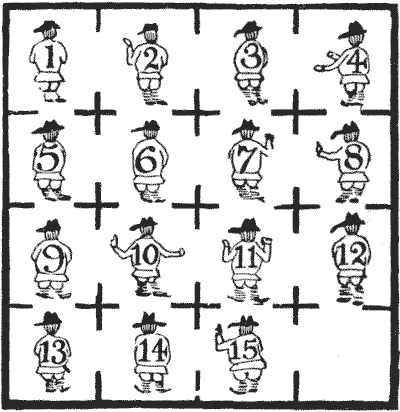The following is the plan of the north wing of a certain jail, showing the sixteen cells all communicating by open doorways. Fifteen prisoners were numbered and arranged in the cells as shown. They were allowed to change their cells as much as they liked, but if two prisoners were ever in the same cell together there was a severe punishment promised them.

Now, in order to reduce their growing obesity, and to combine physical exercise with mental recreation, the prisoners decided, on the suggestion of one of their number who was interested in knight's tours, to try to form themselves into a perfect knight's path without breaking the prison regulations, and leaving the bottom right-hand corner cell vacant, as originally. The joke of the matter is that the arrangement at which they arrived was as follows:— \[\begin{array}{cccc} 8&3&12&1\\ 11&14&9&6\\ 4&7&2&13\\ 15&10&5 \end{array}\]
The warders failed to detect the important fact that the men could not possibly get into this position without two of them having been at some time in the same cell together. Make the attempt with counters on a ruled diagram, and you will find that this is so. Otherwise, the solution is correct enough, each member being, as required, a knight's move from the preceding number, and the original corner cell vacant.
The puzzle is to start with the men placed as shown in the illustration and show how it might have been done in the fewest moves while giving a complete rest to as many prisoners as possible.
As there is never more than one vacant cell for a man to enter, it is only necessary to write down the numbers of the men in the order in which they move. It is clear that very few men can be left throughout in their cells undisturbed, but I will leave the solver to discover just how many, as this is an essential part of the puzzle.
Solutions: 1
This eBook is for the use of anyone anywhere in the United States and most other parts of the world at no cost and with almost no restrictions whatsoever. You may copy it, give it away or re-use it under the terms of the Project Gutenberg License included with this edition or online at http://www.gutenberg.org. If you are not located in the United States, you'll have to check the laws of the country where you are located before using this ebook.